





























MIDWEEK UPDATE 18 FEBRUARY 2015
By The Pilot's Post Team
Plan your weekend
Forthcoming events
This week in aviation history
Aviation News
Advertising rate card


27 February-1 March February: Swellengrebel fly-in. Contact Pieter Venter pventer@vgv.co.za Cell: 083 250 9504
28 February: Bethlehem Aero Club annual Sling, Bushbaby and chopper fly-in. Contact Izak Venter e-mail: izak@motsu.co.za or Francois Marais e-mail: info@stanfra.co.za
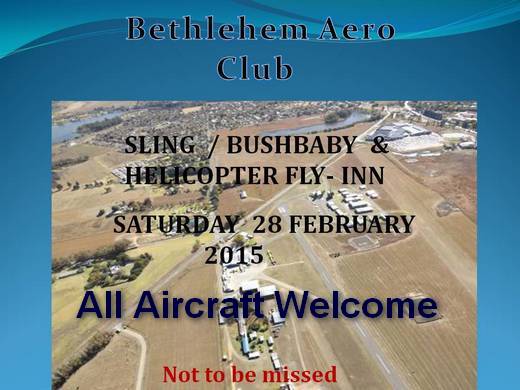
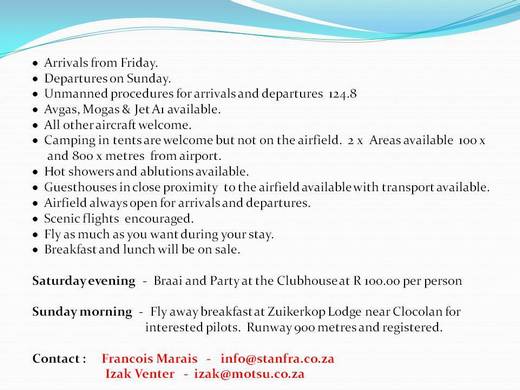
7 March: SAAF Museum flying training and open days. Contact Capt. Kobus Kapp 012 351 2342 or E-mail: webmaster@saafmuseum.org
7 March: SAPFA Fun Rally Stellenbosch. Contact Alewyn Burger email alewyn@burger.org.za
21 March: SAPFA Fun Rally Virginia Airport. Contact Mary de Klerk e-mail: maryd@expandingbranding.co.za
21 March; Touring Motor Glider Fly-in Kittyhawk. 2015. Contact Marietjie van Niekerk 0827656670 marietjievn@gmail.com
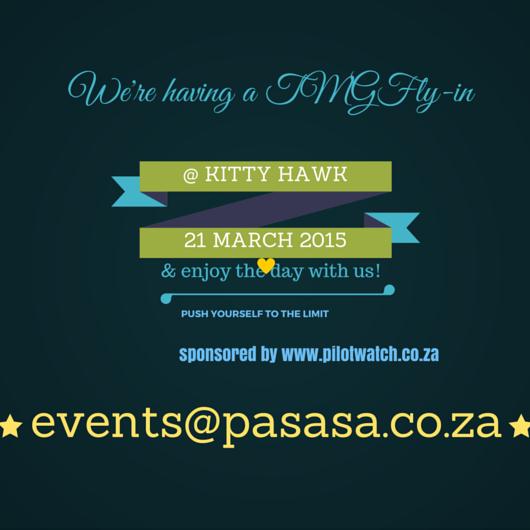
21-22 March: RV's at Parys. Pylon event, a formation competition, an aerobatics event (competition?) as well as possibly a "best build" competition. Contact Scully Levin e-mail: flyboys@global.co.za
27 March: Bethlehem fly-in and Riana Nel show. Contact Jacolene Jacobs 082 854 1003
28 March: Bethlehem Aero Club fun navigation rally. Contact Izak Venter e-mail: izak@motsu.co.za or Francois Marais e-mail: info@stanfra.co.za
27 - 28 March: Uitenhage Wings & Wheels festival. Contact Lourens Kruger 082 320 2615 Website: www.wingsandwheelsfestivalutenhage.co.za
28 - 29 March: Sports Aerobatics Club North-West regionals - Klerksdorp. Contact Annie Boon chunge@mweb.co.za
4 April: SAAF Museum flying training and open days. Contact Capt. Kobus Kapp 012 351 2342 or E-mail: webmaster@saafmuseum.org
11 April: Fashkosh (Stellenbosch) Website: www.stelfly.co.za Contact Alewyn Burger Alewyn@burger.org.za Cell: 082 416 1951
11 April: Henley Air Annual Skills Day at Rand Airport.
15 to 18 April: AERO Friedrichshafen dedicates itself in offering a significant collection of aviation related products and accessories. Exhibitors will be showing engines, modern ultra-lights, powered aircraft, avionics and related products and services. Over the years, this show has gained huge reputation from all over the world and the positive reaction from the attendees has motivated the exhibitors to improve the existing range and manufacture more such effective spare parts and products. For further information on the tour African Pilot is planning please send an e-mail to Athol Franz: editor@africanpilot.co.za. The idea is to get a package deal together for about 10 to 12 persons wishing to visit AERO Friedrichshafen.
17 & 18 April: Zebula airshow. Contact: Paul Weich 083 290 6525 e-mail: pdweich@mweb.co.za
18 to 29 April: Sun 'n Fun Tour 2015, Lakeland, Florida, USA. Contact Neil Bowden: e-mail: neil1@telkomsa.net
Neil Bowden will once again be organising a tour to the USA's second largest fly-in, the Sun 'n Fun Fly-in and International Expo. In addition to the airshow, we will be arranging an excursion to the Kennedy Space Centre. A great new feature here is the Space Shuttle Atlantis exhibition building housing the original Atlantis Shuttle. Also planned is a visit to the Kermit Weeks Fantasy of Flight Museum which is home to some very rare aircraft and while we are in the area there are planned visits to the theme parks - Disney and Universal. The price is from R14 750 per person plus airport tax (about R7 400).
25 April - 2 May: 8th NAC Fly Away Namibia. Contact Deneys Potgieter 082 891 4354 or deneys.potgieter@nac.co.za
29 April-3 May: Aero Club Air week at Parys airfield contact Kev Storie 011 082 1100 Website: www.aeroclub.org.za
1 - 2 May: Lowveld Airshow (Nelspruit) Cell: 079 499 5733 Contact Willemien Hodgkinson e-mail: willemien.hodgkinson@ffa.co.za
8 - 9 May: SAAF Museum Swartkop Airshow, Pretoria Contact Lt. Col Mike O'Connor e-mail: oc@saafmuseum.org Tel: 012 351 2290
8 - 10 May: Battlefields fly-in (Dundee) Lourens Roos 082 875 5419
E-mail: stay@battlefieldslodge.co.za E-mail: nan@battlefieldslodge.co.za Website: www.battlefieldslodge.co.za
15 to 17 May: Bethlehem Aero Club / EAA Chapter 1500 fly-in weekend. Contact Izak Venter e-mail: izak@motsu.co.za or Francois Marais e-mail: info@stanfra.co.za
16 May; SAPFA Fun Rally Krugersdorp. Contact Frank Eckard e-mail: frank.eckard@mweb.co.za

February 18 1973 - Daniel Bouchart and Didier Potelle land 19,568 feet up on the summit of Mount Kilimanjaro, Tanzania in an SA 319 B Alouette II helicopter.
February 18 1930 - Elm Farm Ollie ("Nellie Jay" and post-flight as "Sky Queen") becomes the first cow to fly in a fixed-wing aircraft and also the first cow to be milked in an aircraft.
February 18 1921 - First successful flight with a helicopter by Étienne Oehmichen.
February 19 1916 - Death of Ernst Mach, Austrian physicist and philosopher, noted for his contributions to physics such as the Mach number and the study of shock waves
February 20 1977 - Death of Cristoffel Johannes "Boetie" Venter, South African WWI fighter ace, Director-General of the SAAF during WWI and later, director of South African Airways.
February 20 1875 - Birth of Marie Marvingt, French athlete, mountaineer, and aviator, and the most decorated woman in the history of France. First woman to fly combat missions as a bomber pilot during WWI, a qualified surgical nurse, first trained and certified Flight Nurse in the world. She worked for the establishment of air ambulance services throughout the world.
February 22 1913 - French aviator Jules Védrines becomes the first pilot to fly over 100 mph, behind the controls of a Deperdussin Monocoque near Pau, France.
February 23 1916 - Birth of Paul Warfield Tibbets, Jr., brigadier general in the USAF, best known for being the pilot of the B-29 'Enola Gay', the first aircraft to drop an atomic bomb in the history of warfare.
February 23 1901 - Birth of Ruth Rowland Nichols, American aviation pioneer, who was the only woman to hold simultaneous world records for speed, altitude, and distance for a female pilot.
February 24 1983 - The youngest pilot known to have made a solo flight in a powered, heavier-than-air, flying machine takes to the air for the first time at age of 9 years 316 days. The flight takes place near Mexicali, Mexico and the aircraft the boy pilots is a Cessna 150.
February 24 1921 - First flight of the Douglas Cloudster. It is the first airplane to lift a useful load exceeding its own weight.

CIRRUS AIRCRAFT DELIVERIES IN 2014 DRIVE STRONGEST PERFORMANCE IN SIX YEARS
Cirrus Aircraft announced that new aircraft shipments in 2014 were the best company performance since 2008 as the Cirrus SR22 maintained its position as the best-selling airplane in its segment for the 12th year in a row. New unit deliveries for 2014 totalled 308, a 12% increase over 2013, securing the industry's leading market share for the category. Cirrus Aircraft has now delivered over 5,800 new aircraft and the global Cirrus fleet has amassed over six million flight hours.
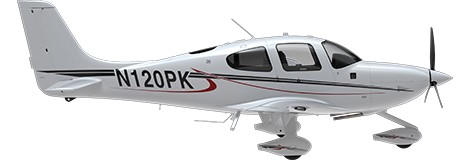
Cirrus Approach™ to Safety
As of early 2015, the Cirrus Airframe Parachute System (CAPS®) had safely returned 104 people to their families, emphasizing the importance of this unique safety system to Cirrus pilots, owners and operators. More recently on 25 January 2015, Cirrus Aircraft received widespread coverage when a pilot ferrying a Cirrus over the Pacific Ocean used CAPS for a safe recovery and the entire event was captured on video by the U.S. Coast Guard.
In addition to being standard equipment on every aircraft Cirrus has ever made, CAPS is also a focus of Cirrus Approach, an on-going training initiative designed to enhance Cirrus pilot safety. Cirrus Approach incorporates learning scenarios in which the pilot's best option is to utilize CAPS and this training has made a significant impact on improving Cirrus' accident survival rate - a rate which has been better than the total general aviation rate for three consecutive years.
ANTONOV TO SUPPLY TWO AIRCRAFT TO CUSTOMERS
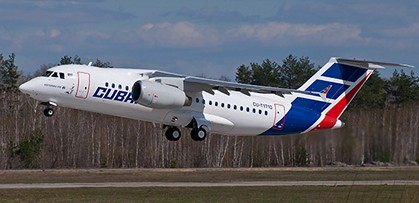
Besides, a group of Korean specialists who came to the Company for acceptance of the second AN-148 works at ANTONOV. For today the work on acceptance of documentation has been completed and acceptance works have been started. In the middle of the month it is planned to pass the aircraft to Korean customer.
Sonex Aircraft is excited to report the achievement of several major milestones in the SubSonex Personal Jet program during the month of February: The first SubSonex kit shipped from the Sonex factory; Four new SubSonex model JSX-2 pilots were minted in Moriarty, NM; and Bob Carlton received his Low-Level Statement of Aerobatic Competency (SAC) card for the SubSonex, in-preparation for the 2015 air show season!
On Thursday, February 12th, the first SubSonex kit left Sonex Aircraft headquarters in Oshkosh, destined for customer Redge Greenberg of Durango, Colorado. The Ultra-Quick Build Kit was transported in the optionally available Triton TC 167 enclosed trailer by Sonex staff to Greenberg's home.
This is the first in a series of seven kit deliveries included in the first kit production run, and marks the conclusion of an intense six month effort to bring JSX-2 from prototype aircraft to a fully-developed quick build kit product.
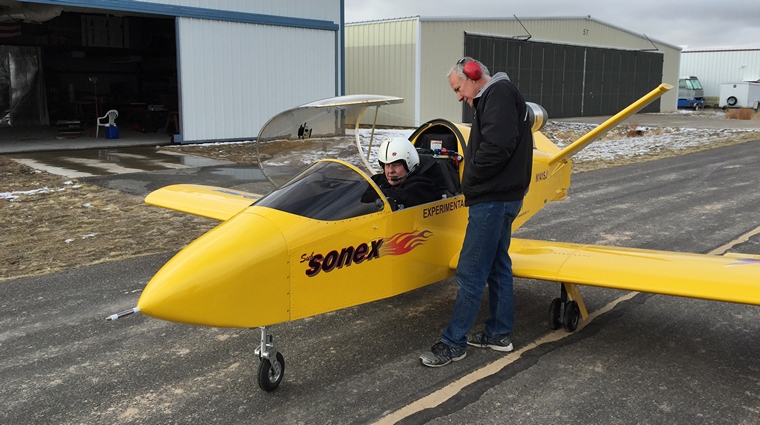
"I hold commercial glider, helicopter & single engine land licenses, accumulating 4500+ hours in numerous aircraft," writes Greenberg, "but I never got the chance to fly a jet. I first saw the prototype of the SubSonex at Oshkosh, and followed the development for over a year. When Sonex offered the jet as a kit, I was first in line. Like my RV8, the SubSonex is aerobatic, but the Sonex company also included a ballistic parachute for extra safety. I'm looking forward to finishing my SubSonex soon and adding jet capability to my aviation skills."
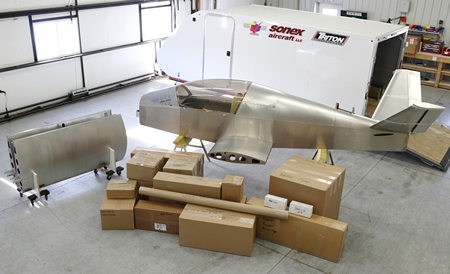
During the weekend of February 1st, four new pilots became qualified to fly SubSonex JSX-2. Sonex Aircraft President John Monnett and Sonex CEO Jeremy Monnett travelled to Moriarty, New Mexico to join Designated Pilot Examiner (DPE) Bob O'Haver and BonusJet flight instructor Billy Hill in making their first flights in SubSonex JSX-2 and subsequent qualifying flights for SubSonex permanent Letters of Authorization (LOA). Moriarty airport, home of SubSonex chief test pilot and air show performer Bob Carlton, is also the base of Carlton's BonusJet training program through his company, Desert Aerospace. SubSonex customers can obtain dual instruction in the jet-powered
TST-14 Bonus sailplane, dubbed the "BonusJet," using the same PBS TJ-100 turbojet systems used in the SubSonex to contribute toward their SubSonex LOA's. DPE O'Haver is available to the BonusJet program for issuance of SubSonex temporary and permanent LOA's to qualifying pilots.
On Saturday, all four pilots made their first flights of SubSonex JSX-2, all four with diverse flying backgrounds from highly-experienced jet pilots O'Haver and Hill, to JSX-1 qualified pilot John Monnett, to piston Sonex pilot Jeremy Monnett, who recently completed the BonusJet training program.
"Remarkably, all four flights looked nearly identical," commented Jeremy Monnett, "which is a testament to SubSonex JSX-2's outstanding flying qualities."
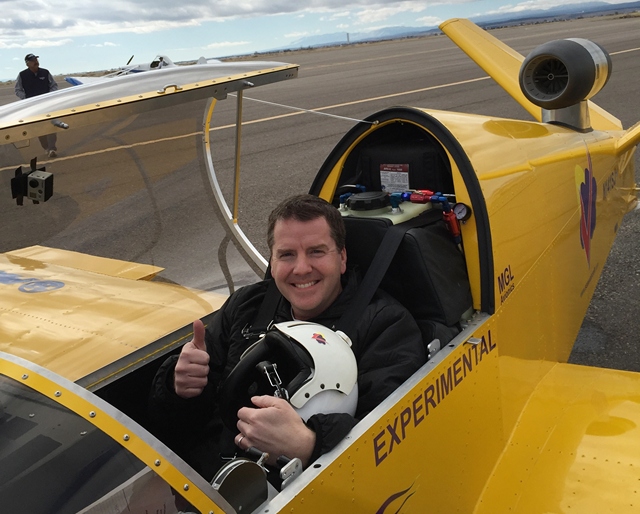
The weekend's flying concluded on Sunday, with permanent LOA checkrides for Bob O'Haver (administered by another visiting DPE), and checkrides for John and Jeremy Monnett, with a check ride for Billy Hill taking place later in the week. Being a single-place aircraft, SubSonex permanent LOA checkrides are administered by observation from the ground via radio contact from the DPE with a GoPro video camera mount on-board to document the flight and review the demonstrated maneuvers.
"This is EASY to fly," remarks Jeremy Monnett on-camera after his first flight, joking to Bob Carlton, "sorry to burst your ego, Bob!" as Carlton was no longer the only SubSonex JSX-2 qualified pilot by the end of the day.
Not to be out-done by Jeremy, Bob Carlton has been practicing a new air show routine in SubSonex JSX-2 for the 2015 season! Currently booked at EAA AirVenture Oshkosh 2015 and the 2015 Rocky Mountain Air Show with more show dates pending, Carlton has put-together a SubSonex show unparalleled by jet acts of the past including maneuvers such as tail slides (usually taboo in a jet), hammerheads and non-stop action with tight turns inside the typical piston aircraft air show box. Carlton has been practicing the show extensively over the past month, and obtained his Low-Level Statement of Aerobatic Competency (SAC) card for the SubSonex on February 12th in Phoenix, Arizona. "Thanks to Tim Weber for the use of his hangar, Bill Cornick for coming from California to do the evaluation and Bob Bishop for coaching me last weekend in Tucson," writes Bob.
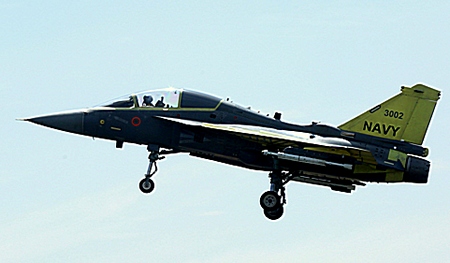
The flight was piloted by Captain Shivnath Dahiya, an experienced Test Pilot from Indian Navy with the National Flight Test Centre (NFTC). The launch was accomplished under telemetry control exercised by Test Director, Commander J D Raturi and Safety Pilot, Commodore J A Maolankar, the Chief Test Pilot of NFTC. The chase aircraft cover was provided by LSP2 piloted by Gp. Capt. Suneet Krishna (Retd) with the Test Director being Gp. Capt Prabhu and the Safety Pilot being Gp. Capt. RR Tyagi.
Maiden Flight of LCA Naval Prototype 2The design teams were guided by Programme Director ADA, Mr P S Subramanyam ensured that systems meet the stringent requirements of Carrier borne aircraft. The teams were ably supported by the Certification agency, CEMILAC and the Quality Assurance agency, CRI (LCA), Indian Navy, DRDO agencies, CSIR agencies (NAL & CSIO), other Public and Private Sector participants.
The event marks the growth of indigenous LCA (Navy) program, aimed to achieve Carrier Compatibility technology demonstration including arrested landing and ski-Jump take off, initially from the Shore Based test facility, Goa.
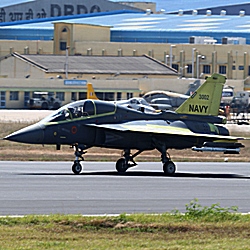
The ADA LCA (Navy) Programme Office, under Cmde C D Balaji (Retd) is exhilarated by the addition of NP 2 as a Flight Test platform. NP 2 has been built with vision and foresight. It addresses several systemic deficiencies observed whilst making progress on flight test of Naval Prototype 1. It incorporates most avionic hardware components promised to the customer, Indian Navy. During design and build NP 2 has been customized (Plug & Play) to incrementally accept modifications for Carrier Landing aids like Levcon Air Data Computer, Auto-throttle, external and internal Angle of Attack lights. NP 2 is the lead aircraft for arrestor hook integration, Derby Beyond visual Range missile and tactical data link. The inclusion of NP 2 into the LCA (Navy) flight test stable is a significant milestone in the indigenous Carrier borne aircraft development program.
EMBRAER EXECUTIVE JETS DELIVERS FIRST LEGACY 500 IN AUSTRALIA
"The Legacy 500 is proving itself to be a very capable executive jet and well suited to the Australia market. It offers excellent field performance and easy transcontinental range," said Marco Túlio Pellegrini, President and CEO, Embraer Executive Jets. "We are grateful for the confidence that this customer has placed in Embraer, and we are fully committed to supporting their operations."
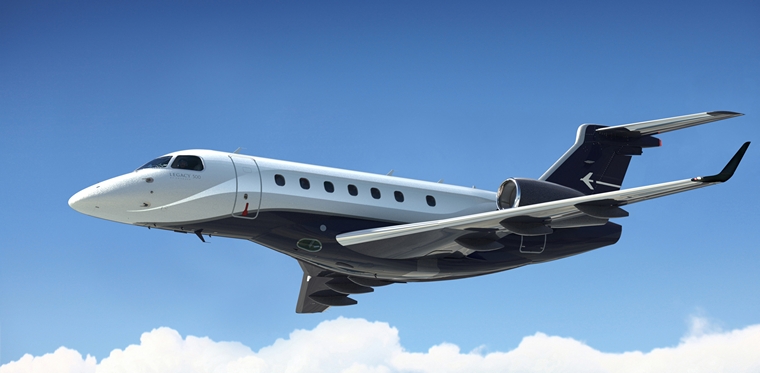
"The owner is an astute businessman who carefully selected the Legacy 500 after reviewing all the aircraft in this class," said Peter Norris, Managing Director of Norris Aviation Services Australia Pty Ltd. "In the end, safety, the clean sheet design, advanced systems, excellent performance, quiet comfortable cabin and professional presentation and support by Embraer, made the Legacy 500 the only logical choice."
To support the operation of the Legacy 500 in the Australasia region, Embraer Executive Jets has authorized Execujet to provide maintenance for the Legacy 500 in Australia. This is in addition to the existing maintenance capability it has to support the Phenom 100, Legacy 600 and Legacy 650 customers. Hawker Pacific, in Singapore, is also authorized to provide full maintenance support to Legacy 500 customers. In addition, Embraer has a regional distribution centre in Singapore, which has ready stock of spare inventory, including parts for the Legacy 500.
CHILEAN SOCCER TEAM'S PLANE FOUND FIVE DECADES AFTER MOUNTAINSIDE CRASH
Chilean mountaineers pose for a photo on what they say is the wreckage of a plane that crashed in the Andes mountains 54 years ago, killing 24 people, including eight members of a professional soccer team. (Leonardo Albornoz/AP)
In early April 1961, the top-division Chilean soccer team Green Cross piled into a fixed-wing propeller plane headed home for the country's capital, Santiago. They had just played an away game in the Copa de Chile, Chile's domestic soccer cup. Then, somewhere over the Andes Mountains, the plane crashed. All 24 passengers - including eight team members - were presumed dead, and the wreckage remained missing for 54 years.
Now, Chilean mountaineers say they have found passengers' bones and the plane's mutilated remains, its propeller buried in stone, some 215 miles from Santiago. The discovery solves a decades-old South American mystery.
"It was a breath taking moment, and we felt all kinds of sensations. One could feel the energy of the place and breathe the pain," Leonardo Albornoz told Chile's Channel 7, according to the Associated Press.
"The plane is more than 10,000 feet above sea level," he told the Mirror. "A large part of the fuselage is still intact and a lot of material, including human bones, are scattered around the wreck."
The plane crash brings to mind a widely publicized disaster that followed in 1972, when a Uruguayan aircraft carrying a rugby team went down in the Andes in Argentina, near the border with Chile. The plane's survivors became the inspiration for numerous documentaries, movies and books, most notably the 1993 film "Alive," which was based on a book by the same name.
But this was a different disaster. On April 3, 1961, the Green Cross players split up between two planes. One made a few stops before landing in Santiago, and the other disappeared in flight. Rescue workers searched for weeks and found no sign of the Douglas DC-3 or its passengers. Memorials were held for the players - their families had no bodies to bury.
When mountaineers found the wreckage, they said they could see the remains. They have not released the exact location of the 1961 crash to keep the site from being looted.
"We don't want this place to be defiled and the remains taken as trophies. You have to remember people died here and their families deserve respect," Albornoz said, according to the Scottish Daily Record.
http://www.washingtonpost.com/news/morning-mix/wp/2015/02/09/chilean-soccer-teams-plane-found-five-decades-after-mountainside-crash
NEW CESSNA SKYHAWK ORDER TO EXPAND CIVIL AIR PATROL FLEET

"Few things are as fulfilling to all of us than our continued support of the CAP, our largest customer for single-engine piston aircraft," said Joe Hepburn, senior vice president, Piston Aircraft. "The men and women of the CAP are involved in search-and-rescue operations, disaster relief, flight training, youth development and in promoting aviation throughout the country. We are proud to provide them aircraft in support of their mission."
The Skyhawks, produced at the company's facility in Independence, Kansas will be delivered throughout the first half of 2015, replacing older models in CAP's fleet. In addition to the standard equipment on the aircraft, including the Garmin G1000 avionics suite, the new CAP Skyhawks will be equipped for glider towing. The CAP operates a fleet of 550 aircraft, most of which are Skyhawks and Cessna Skylane 182 piston aircraft. It also operates 46 gliders.
"Cessna is one of our most valued partners," said Don Rowland, chief operating officer of Civil Air Patrol. "Flying high wing aircraft is very helpful for CAP especially in conducting photo reconnaissance flights for emergency service providers in the aftermath of disasters, and the Skyhawk and Skylane are perfectly suited for our needs."
EMBRAER DELIVERS FIRST E-JET TO AMERICAN AIRLINES
At a ceremony held at the Company's headquarters in São José dos Campos, Embraer delivered to American Airlines the first of 60 firm order E175 jets under the contract signed between the two companies in December 2013. The contract also included options for another 90 E175s, taking the total order potential to 150 aircraft.
American Airlines selected Compass Airlines, a wholly owned subsidiary of Trans States Holdings, to operate the first 20 E175 aircraft under the American Eagle brand. The E175s will be configured with 12 First Class, 20 Main Cabin Extra and 44 Main Cabin seats, for a total of 76 seats.
"There are many E175s already flying in the U.S. market in the colours of the new American, but the delivery of the first aircraft purchased directly by American, and to be operated by Compass, is a special moment for Embraer and its employees," said Paulo Cesar Silva, President & CEO, Embraer Commercial Aviation. "Embraer and American have enjoyed a long strategic partnership, built by the operational success of the ERJ 145 aircraft family. Now, we are very confident that the same success will be achieved with the E175."
"The E175 is an important part of American's fleet renewal, providing us the right size aircraft for the right routes," said Peter Warlick, American's vice president of Fleet Planning. "With a two-class cabin and Wi-Fi connectivity, these modern and efficient aircraft ensure our customers have a seamless transition between regional and mainline flights on the largest network in the world."
Embraer is the only manufacturer to develop a modern family of four airplanes specifically targeted to the 70- to 130-seat segment. Since the formal launch of the program, in 1999, the E-Jets have redefined the traditional concept of regional aircraft by operating across a range of business applications.
The E-Jets family entered revenue service in 2004. Currently, E-Jets are flying with 65 airlines from 45 countries, holding a 62% market share (based on deliveries) in the segment of jets with capacity up to 130 seats. Today, E-Jets are flying with mainline, low-cost and regional carriers, as well as with charter airlines. In June 2013, Embraer launched the second generation of the E-Jets family - the E-Jets E2 - the first of which is slated to enter service in 2018.
SAA (South African Airways) this week completes 60 days of the 90 Day Action Plan commenced last year. The plan, a roadmap to return the carrier to relative stability, was developed to return the business to full implementation of its broader turnaround plan, the Long-Term Turnaround Strategy. A further State guarantee was received from the airline's Shareholding Ministry, National Treasury, to ensure the airline's continued financial stability.
"While it is business unusual at SAA," says Acting SAA Chief Executive Officer Mr. Nico Bezuidenhout, "the implementation of the 90 Day Action Plan has seen immediate beneficial commercial decision making on the one end while cost-compression measures have been substantially tightened to ensure that the business returns to relative stability. This is the objective of the Board and the management of South African Airways and we are intent on returning the business to commercially sound competitive activity in the market."
• Recent and planned network configurations stand to positively impact SAA in the region of R600 million per annum; the genesis being the culling of loss making direct flights between Johannesburg and Beijing and Johannesburg and Mumbai sans sacrificing connectivity through deepened commercial relationships with a number of Gulf-state and other carriers. SAA launches its first direct flight between Johannesburg and the Middle-East on 29 March that will enable further network growth through end-point code-sharing with Gulf carriers, particularly to China and India. SAA has also, during the past two months, grown its sub-Saharan African network due to strong commercial demand with frequency additions between Johannesburg and Maputo, Harare and Mauritius among others. "SAA will announce further network reconfigurations in the coming months as well as new, commercially attractive destinations," says Mr. Bezuidenhout. "It's an exciting time and we are seeing commercially sound network decisions receive full backing from our Board and Shareholder".
• SAA has completed approximately 40% of identified contract renegotiations, which forms part of a strengthening of Governance controls within the procurement area and re-focus on cost compression. This has thus far resulted in annualised savings of R 91 million.
• A key component of the 90 Day Action Plan is a revalidation of the Long-Term Turnaround Strategy (LTTS), which is currently re-evaluating underlying macro-economic and capital structure assumptions and their impact on SAA's strategy. When the LTTS was developed in 2013, the Rand was 40% stronger than it is today and oil cost more than double the current and forecast trading price of Brent crude today. This fundamentally impacts on aircraft economics and demand patterns. Thus a review of SAA's overall response is required, culminating in amendments to SAA's network structure, fleet solution and financial forecasting and planning.
• SAA has also renegotiated fleet lease re-extensions of 3 of its A340 aircraft, already representing a positive impact of R 112 million annually. Further five aircraft lease extensions and renegotiations are expected to yield additional savings in excess of R 150 million later in the year.
• SAA expects to improve operating performance by approximately R 1.25 billion through the implementation of the 90 Day Action Plan, in the financial year ending March 2016.
"The strong implementation progress that is being made on the 90 Day Action Plan has seen tangible steps taken to fundamentally change SAA in financially quantifiable ways," says Mr. Bezuidenhout. "Governance is being strengthened substantially and effort is being applied under trying circumstances to change the public reputation of the business. This focus continues to drive South African Airways toward relative stability at the end of the 90 days in March."
"In its role as flag carrier, SAA serves as an economic enabler with direct and indirect benefits across a wide range of economic activity as well the catalytic impact on both in and outbound tourism." South Africa's geographic end of hemisphere position further emphasises the need for such air services as well as key partnerships with other carriers to maximise connectivity and optimise commercial opportunity. "SAA is open for business, however it is business unusual and intends competing commercially in all markets that the airline currently operates in as well as opening up new markets in time to come; either through extended code share agreements or direct own-metal flights where commercially sustainable."
SAA connects South Africa to its major trade and tourism partners, in so doing supporting 33,000 jobs in South Africa, and contributing R10bn (US$ 900m), or approximately 0.3%, to the country's GDP every year. Approximately 40% of all passengers and more than 50% of all air cargo within and to South Africa last year was carried by the SAA Group or under the SAA code. No South African airline trains more pilots and technicians, procures more from local suppliers or have taken more steps to protect the environment than SAA.


 |
 |
 Copyright © 2024 Pilot's Post PTY Ltd
The information, views and opinions by the authors contributing to Pilot’s Post are not necessarily those of the editor or other writers at Pilot’s Post.
Copyright © 2024 Pilot's Post PTY Ltd
The information, views and opinions by the authors contributing to Pilot’s Post are not necessarily those of the editor or other writers at Pilot’s Post.